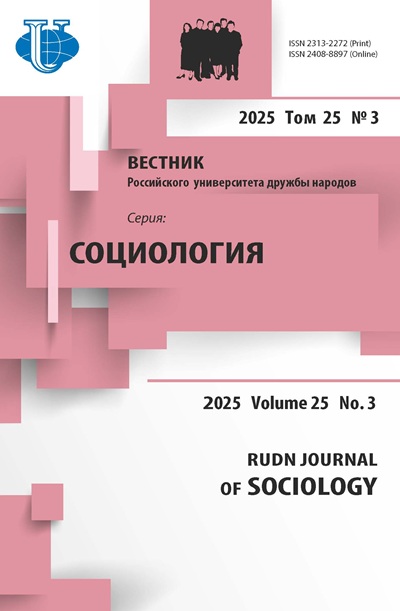Адаптация и погружение в жизненных траекториях женщин, вовлеченных в проституцию
- Авторы: Русакова М.М.1
-
Учреждения:
- Санкт-Петербургский государственный университет
- Выпуск: Том 19, № 1 (2019)
- Страницы: 71-80
- Раздел: Массовые опросы, эксперименты, кейс-стади
- URL: https://journals.rudn.ru/sociology/article/view/20557
- DOI: https://doi.org/10.22363/2313-2272-2019-19-1-71-80
- ID: 20557
Цитировать
Полный текст
Аннотация
В статье рассматриваются адаптация и погружение как части жизненной траектории женщин в проституции, включающей в себя пять последовательных стадий: приближение, вхождение, адаптация, погружение и выход. Цель исследования - описать стадии адаптации и погружения в проституцию на примере женщин, вовлеченных в проституцию в Санкт-Петербурге и Оренбурге. Исследование проводилось по последовательному количественно-качественному смешанному дизайну, состоящему из опроса 896 респондентов и 10 полуструктурированных интервью (выборка конструировалась методом «снежного кома»). В статье представлен анализ данных опроса и тематический анализ полуструктурированных интервью. В ходе исследования были зафиксированы две тенденции в социальном окружении респондентов: разрыв дружеских и детско-родительских связей или отдаление и нежелание раскрывать особенности своей деятельности; наличие партнерских отношений, сопровождающееся разделением деятельности в проституции и вне ее. Женщины, вовлеченные в проституцию, подвержены всем формам насилия со стороны клиентов и организаторов, поэтому неотъемлемой частью адаптации и погружения становится изучение поведения клиентов и выработка путей безопасного взаимодействия с ними, а также способов предотвращения конфликтных ситуаций. Также в ходе исследования была зафиксирована тенденция начала и/или злоупотребления алкоголем и наркотиками по мере вовлечения в проституцию, причем в процессе погружения в эту деятельность тяжесть употребления, как правило, возрастает. Кроме того, многие женщины находятся в пограничном или неудовлетворительном психологическом состоянии. Исследование показало необходимость дальнейшего изучения стратегий вовлечения, адаптации и взаимодействия с клиентами и организаторами секс-бизнеса, а также с ближайшим социальным окружением, не вовлеченным в проституцию, женщин в проституции, причем на всех стадиях их жизненной траектории в проституции.
Об авторах
Майя Михайловна Русакова
Санкт-Петербургский государственный университет
Автор, ответственный за переписку.
Email: rusakova.maia@yandex.ru
кандидат социологических наук, доцент кафедры прикладной и отраслевой социологии Санкт-Петербургского государственного университета
ул. Смольного, 1/3, Санкт-Петербург, Россия, 191124Список литературы
- Курманова Г., Башмакова Е.П., Бутенко Е.Н. Работники коммерческого секса // Социологические исследования. 2000. № 5
- Любовь за деньги / Под. ред. В. Бегальской, А. Вилкина. М., 2017
- Покатович Е.В., Матюшонок В.Д. Ценообразование на рынке онлайн-проституции // Экономическая политика. 2017. Т. 12. № 3
- Романенко В. Трансформация социального пространства женской проституции (на примере молодых женщин, оказывающих сексуальные услуги в Санкт-Петербурге) // Журнал социологии и социальной антропологии. 2015. Т. 18. № 5
- Яковлева А.А. Исследования в труднодоступных группах: опыт использования выборки, управляемой респондентом, и выборки «место-время» // Социология: методология, методы, математическое моделирование. 2011. № 33
- Я-ведьма // Такие дела. 14.06.2018 https://takiedela.ru/2018/06/ya-vedma
- Barton B. Managing the toll of stripping: Boundary setting among exotic dancers. Journal of Contemporary Ethnography. 2007; 36 (5).
- Brewis J., Linstead S. ‘The worst thing is the screwing’: Consumption and the management of identity in sex work. Gender, Work & Organization. 2000; 7 (2).
- Chapkis W. Power and control in the commercial sex trade. Sex for Sale: Prostitution, Pornography, and the Sex Industry. R. Weitzer (Ed.). New York; 2010.
- Chen X.S., Yin Y.-P., Liang G.-J., Gong X.-D., Li H.-S., Poumerol G. et al. Sexually transmitted infections among female sex workers in Yunnan. AIDS Patient Care & STDs. 2005; 19 (12).
- Dalla R.L. “You can't hustle all your life”: An exploratory investigation of the exit process among street-level prostituted women. Psychology of Women Quarterly. 2006; 30 (3).
- Dank M.L. Estimating the Size and Structure of the Underground Commercial Sex Economy in Eight Major US Cities. Washington; 2014.
- Deering K., Amin A., Shoveller J., Nesbitt A., Garcia-Moreno C., Duff P. et al. A systematic review of the correlates of violence against sex workers. American Journal of Public Health. 2014; 104 (5).
- Karandikar S., Prospero M. From client to pimp male violence against female sex workers. Journal of Interpersonal Violence. 2010; 25 (2).
- Malta M., Magnanini M., Mello M., Pascom A., Linhares Y., Bastos F. HIV prevalence among female sex workers, drug users and men who have sex with men in Brazil: A systematic review and meta-analysis. BMC Public Health. 2010; 10 (1).
- Mandiuc A. The impact of a prostitute mother on the child life circumstances. European Journal of Research on Education. 2014; 2 (2).
- Oselin S.S. Leaving Prostitution: Getting Out and Staying Out of Sex Work. New York; 2014.
- Raphael J., Myers-Powell B. From Victims to Victimizers: Interviews with 25 Ex-pimps in Chicago. Chicago; 2010.
- Sanders T. A continuum of risk? The management of health, physical and emotional risks by female sex workers. Sociology of Health & Illness. 2004; 26 (5).
- Sanders T., Campbell R. Designing out vulnerability, building in respect: Violence, safety and sex work policy. British Journal of Sociology. 2007; 58 (1).
- Shannon K., Strathdee S., Goldenberg S., Duff P., Mwangi P., Rusakova M. et al. Global epidemiology of HIV among female sex workers: Influence of structural determinants. Lancet. 2015; 385 (9962).
- Thomas J.C., Tucker M.J. The development and use of the concept of a sexually transmitted disease core. Journal of Infectious Diseases. 1996; 174 (2).
- Vanwesenbeeck I. Prostitutes’ Well-Being and Risk. Amsterdam; 1994.
- Weitzer R. Sociology of sex work. Annual Review of Sociology. 2009; 35.
- Whittaker D., Hart G. Research note: Managing risks: The social organization of indoor sex work. Sociology of Health & Illness. 1996; 18 (3).
- Williamson C. Entrance, Maintenance, and Exit: The Socio-Economic Influences and Cumulative Burdens of Female Street Prostitution. Indianapolis; 2010.
Дополнительные файлы













